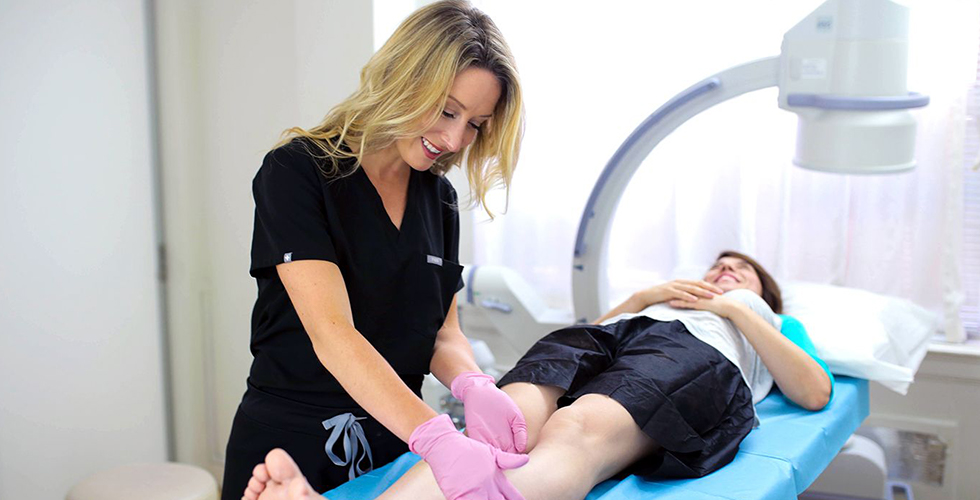What are varicose veins?
Varicose veins are a common condition in which swollen, enlarged veins appear close to the skin’s surface. They usually appear in the legs but can also develop in other parts of the body. Varicose veins can be unsightly and can cause aching and discomfort. Varicose veins affect around 10-15% of the population, with women more likely to develop the condition than men. The risk of developing varicose veins increases with age, but some people also have a genetic predisposition towards them.
Varicose veins occur when the valves in your leg veins become weakened or damaged, causing the veins to become dilated and twisted. This causes a buildup of blood in the veins, leading to enlargement and bulging of the veins. Factors that can predispose someone to develop varicose veins include pregnancy, obesity, a sedentary lifestyle, occupations that involve sitting or standing for lengthy periods, and straining during bowel movements.
Varicose veins can affect your overall quality of life, as they may cause pain, cramping, fatigue, and swelling of the legs. In severe cases, they can also cause ulcers. The good news is that various treatments are available for varicose veins. Treatments for varicose veins may include lifestyle changes, such as weight loss, exercise and elevating your legs, wearing compression stockings, and minimally invasive procedures, such as laser ablation, radiofrequency ablation, venaseal, clarivein, ambulatory phlebectomy, and sclerotherapy.
If you have varicose veins, please contact a vein doctor in Long Island to explore your treatment options. Long Island Vein Treatment is a group of medical centers for vein treatment specializing in the latest, minimally invasive varicose vein treatments in Long Island. We have offices in West Islip, Jericho, Port Jefferson, and Hampton Bays. Our medical center for vein treatment in West Islip is on the Montauk Highway bordering Suffolk County and Nassau County.
Please schedule an appointment to explore your treatments for painful varicose veins.

What’s the difference between spider veins and varicose veins?
Spider veins, sometimes known as telangiectasias, are small dilated blood vessels that appear commonly on the legs, though they may also show up in other areas of the body. They start as small clusters of red, purple, or blue veins right beneath the skin’s surface and often appear in a spider-like shape. Spider veins are caused by increased pressure in the veins, and they’re more likely to develop in people over the age of 40, pregnant women, and those who stand or sit for long periods.
Varicose veins, on the other hand, are rope-like and appear on the legs but can sometimes be found in other areas of the body. These veins are swollen, often bulging, and can appear in shades of blue, purple, or red. Unlike spider veins, varicose veins usually protrude outwards from the skin’s surface and can cause uncomfortable symptoms, such as aching, tired legs, or throbbing in the affected areas. Varicose veins are caused by increased pressure in the veins and weakened valves.
Although both spider and varicose veins are treatable, people should contact a vein specialist to get a proper diagnosis and determine the best treatment. Treatment options vary, ranging from self-care strategies and wearing compression stockings, to minimally invasive procedures, like sclerotherapy, endovenous laser ablation, and venaseal treatment.
What causes varicose veins?
Varicose veins can be an unsightly and uncomfortable problem for many people. Unfortunately, they can be difficult to get rid of once they appear. Varicose veins are caused by weakened valves in the veins, which then become stretched and dilated. Our veins contain valves, which open and close to allow the blood to move up to the heart against the force of gravity. When these valves weaken, they allow the blood to flow backward and pool in the vein, which causes it to enlarge.
What are the risk factors for varicose veins?
While anyone can develop varicose veins, a few factors may put you at a greater risk.
- Age is a major factor in the development of varicose veins. As we age, the walls of our veins become thinner and weaker. As such, they’re less able to effectively carry blood back to the heart and other areas of the body. This backflow of blood can then cause the veins to become enlarged and twisted, leading to the development of varicose veins.
- Hereditary factors can also contribute to varicose veins. If you have a family history of them, you may be at a greater risk of developing them yourself.
- Gender is also a risk factor for varicose veins, as women are more likely to develop them than men. This may be due to fluctuations in hormone levels caused by pregnancy and menopause that can weaken the walls of the veins. Additionally, women who take certain types of birth control pills may experience a higher risk of developing varicose veins.
- Lifestyle choices and certain medical conditions, such as obesity and heart disease, can also increase your risk of developing varicose veins. Obesity or excess weight can put extra strain on the veins, causing them to become weakened. Similarly, those with heart disease may experience circulation problems, resulting in the development of varicose veins.
- In addition to these risk factors, standing or sitting for long periods can also contribute to the development of varicose veins.
If you believe you may be at risk for developing varicose veins, you must talk to your vein doctor. They can help you determine your level of risk and provide you with tips and treatment recommendations to help manage your condition.
